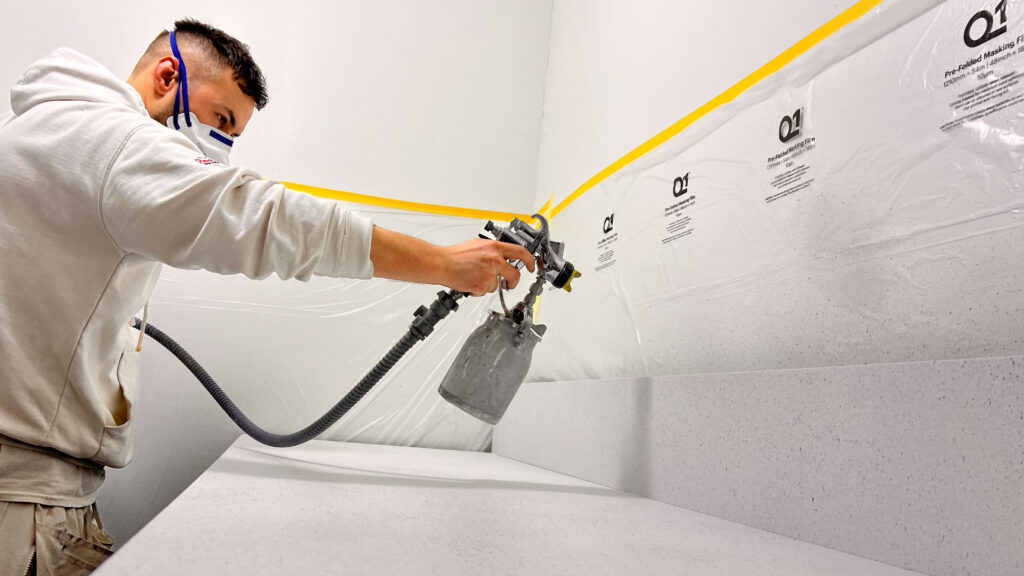Many decorators will decide to do some training. They may have heard about spraying and that it could help improve the finish of their work, and they realise improving their finish means making more money.
They may pay for this course themselves or through CITB training grants. There are several reasons why someone might pay for it themselves, but usually, it’s simply that decorators don’t know how to claim the grants available through the CITB or don’t know about CITB at all.
Here we will explain the simple process in layman’s terms so that you can decide if CITB training grants are something you could do.
How much CITB training grants can you get for your training?
First of all, how much are we talking about?
The amount of funding you can claim depends on the size of your business, and we discuss this at length in our previous blog, “Who are the CITB and what are CITB grants?
However, in simple terms, if you are an employer with no PAYE staff but you are registered for the Construction Industry Scheme (CIS) then you can claim up to £2,500 per year. If you have some PAYE staff, you can claim up to £5,000 per year. If you are a larger employer, you can claim £7,500 per year, and finally, if you are a huge company, you can claim up to £10,000 per year.
Generally, the larger companies are already claiming all the funding and CITB training grants that they are entitled to, it’s the sole traders and small companies who are unaware of the money they can claim towards training. Usually, missing out on £2,500 for sole traders and £5,000 if you have employees.
Download Now: Further CITB Funding Information
Eligibility for CITB training grants
When we talk to decorators about how they can get their course paid for by the CITB, they usually assume they will not be eligible for the CITB training grants. But contrary to this, we find that most people are eligible. All you need to be is registered with the CITB. If you are not already registered, then it’s a simple process. You will get a CITB levy number sent to you once you are on their system, which is used to track the money given to you and the courses you do.
If you are a micro business and use sub-contractors to help on some of your projects, then you may be eligible. Though the subcontractors must be genuine CIS sub-contractors, not just some mate you paid cash to. Better than that, you can also fund your subcontractors for the training, so it’s a nice sweetener for your regular subbies.
If you have PAYE employees, you are also eligible and can claim more money, up to £5,000. They must be a decorator and employed by you. An apprentice who is PAYE is also eligible.
If you are self-employed and have no intention of using a sub-contractor or employing anyone, you won’t be eligible. If you are thinking of developing your business in the future and want to get some proper training, then it’s worth considering at least using a sub-contractor. The CITB do audit the companies that claim funding and will ask for either proof of CIS or PAYE, so don’t be tempted to wing it.
How to apply?
The simplest way to apply for funding is to contact us, and we will send you the form. We can then chat on the phone about the courses you plan to take and get the relevant codes across. This form is then emailed to the CITB (skills.training@citb.co.uk.) before the monthly deadline, which is the last working day of the month.
Your application will be reviewed over the following two weeks (after the deadline date, not your submission date), and you will be emailed the outcome.
If approved, you’ll either get the money upfront in 4 to 6 weeks or in some cases, once you’ve completed your chosen courses. It varies from case to case, depending on how new you are to the CITB. More on this in the next section.
Though we are here to help, you can apply directly if you feel confident with this. The form is straight forward, and training providers will have the codes that you need. They are on the CITB website if you want to look them up yourself.
Check it out here à https://www.citb.co.uk/levy-grants-and-funding/grants-and-funding/skills-and-training-fund/skills-and-training-fund-for-small-and-micro-sized-businesses/
You can also read about the funding and look at the courses on offer.
How do you receive and send the money?
The money you have applied for is paid into your bank account and then paid to the training provider. CITB does NOT pay the money directly to the training provider.
We generally find that if you’ve been registered with the CITB for some time (and hence a good credit history), the money is paid to you immediately so that you can then book your course. However, if you are a new CITB customer, you’ll need to build some trust, so you’ll be paid once you have been invoiced for the courses. We can discuss this process with you, as there are a few options.
If you are VAT registered, CITB does not pay the VAT element because you can claim it back. However, the CITB will include this in your funding if you are not VAT registered.
How can PaintTech help with your application?
We will help in any way, from simple advice and assurance to helping to complete the application form. The form is easy to complete, but as we all know, if you put the wrong thing in the wrong box, then the application gets rejected. You can apply again, but it’ll be another month waiting, so getting it right the first time you apply is essential.
It’s a little bit like when you apply for a new passport. You provide all the information, but the post office will check it for you before sending it off so that you know it’s correct. We have years of experience filling out forms, it’s part of what we do. So, if you have any questions or worries along the way, we’re here to help.
We also have a good working relationship with the CITB, so any questions that we don’t know, we can find out for you.
Book a call with a member of our team to see how CITB can help you progress in your career.





